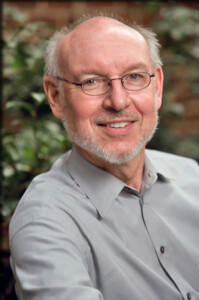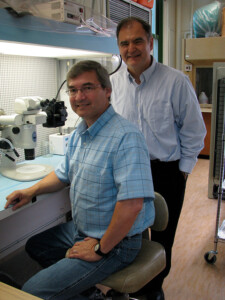ESF mourns the loss of Professor Richard Hawks ‘72, Drs. Chuck Maynard, and Bill Powell
ESF lost three pillars of its community this past year: Professor Richard Hawks ‘72, Drs. Chuck Maynard, and Bill Powell. Each left their mark not only on ESF, their students, colleagues, and friends, but also on the world well beyond the College’s boundaries.
Richard “Rich” Hawks ‘72
(Nov. 20, 1947-Jan. 31, 2024)
 “Richard was the personification of the program and the profession. His warm and outgoing personality was a perfect reflection of an optimistic discipline,” said Margaret Bryant, chair of the Department of Landscape Architecture (LA).
“Richard was the personification of the program and the profession. His warm and outgoing personality was a perfect reflection of an optimistic discipline,” said Margaret Bryant, chair of the Department of Landscape Architecture (LA).
Her memory of the man who led the department for 25 years is shared by all fortunate to have known him.
“Richard was just a wonderful human being,” said Emeritus Professor George Curry of his former student and colleague. “He believed strongly in community, whether it be the community of Plymouth Church or the department, the college, or the profession. He was a committed human being.”
Remembered as a mentor, colleague, and close friend with joie de vivre wrapped in a wonderful sense of humor, Richard put students first. He worked across departments to ensure LA students received the full benefits of attending a college of environmental science and forestry, as he felt it was a place where the profession could thrive and evolve through such connections.
Richard began his landscape architecture journey at ESF as an undergrad, worked at EDAW in San Francisco, and completed his master’s at Harvard Graduate School of Design. He returned to campus as a faculty member in 1979 and rose to full professor. As department chair, he was a champion and advocate for his faculty, staff, and students.
Richard loved mentoring students – in studios and the off-campus program. He was a passionate advocate for the field of landscape architecture, “traveling constantly, meeting with people in influential organizations and firms and elevating the visibility of our students and faculty,” Bryant recalled. He seized upon every opportunity to promote the industry to potential LA students and students who hadn’t considered LA.
Richard was also a student favorite. He didn’t simply lecture; he engaged his students, gained their attention, and kept their interest, said Tony Miller ‘72, a close friend and colleague. He spoke to and with his students, never at them, and empowered them to seek and take leadership positions. His teaching style not only impacted his students but also those with whom he worked.
“I saw how a good communicator worked, and, I believe, learned how to be a better teacher,” said Miller. “Rich had an incredible ability to work with others as their equal through the use of his self-deprecating humor. He never tried to overpower you with his position, but rather through dialogue.”
After retiring, Richard was an avid cyclist, completing four Five Borough Bike Tours and riding many miles on the Erie Canal and Onondaga Lake trails, often sharing those rides with friends. He enjoyed golf (once hitting a hole-in-one), skiing, travel, and all things Bob Dylan. And if we agree with Bob Dylan that “A man is a success if he gets up in the morning and gets to bed at night, and in between he does what he wants to do,” it is safe to say Rich Hawks was highly successful.
Chuck Maynard (March 25, 1951-Feb. 5, 2024) and William Powell (Oct. 4, 1956-Nov. 12, 2023)

Chuck Maynard and William Powell
It’s difficult – if not impossible – to talk about Drs. Chuck Maynard and Bill Powell separately, as their lives and work were as entwined as the DNA strands of the American chestnut trees they researched.
Bill became aware of chestnut blight while pursuing a Ph.D. in biology at Utah State University, where he worked with hypovirulent (virus-infected) strains of the blight. He joined ESF’s then-Department of Environmental and Forest Biology in 1989.
Chuck did his undergraduate and graduate studies at Iowa State University, receiving his Ph.D. in forest biology in 1980. Shortly after graduating, he moved to Syracuse to do research and teach in what was known as the Department of Forest and Natural Resources Management.
Their collaboration began in 1990, when approached by the New York Chapter of The American Chestnut Foundation and asked if they could save the American chestnut tree using a “new” scientific approach: biotechnology.
They accepted the challenge and formed the American Chestnut Research and Restoration Project at ESF. Little did they know they had laid the foundation of their legacy.
Bill and Chuck were the founders and directors of the project, but they were also teachers, mentors, leaders, and friends. When you ask people about Bill and Chuck the same words come up: kind, open, optimistic, patient, welcoming, supportive.
To say they were two of the kindest people on campus would be accurate.
They complemented each other: Bill was the molecular biologist, while Chuck was the tissue culture specialist. Bill’s lab made the genes, while Chuck’s lab put the genes into the trees. With each step of the research, they possessed a keen talent for communicating and sharing their work in an easy-to-understand manner making it accessible to all and drawing in thousands of supporters for the research.
The pair not only created a blight-resistant American chestnut; they also created a cadre of students, researchers, and scientists who embraced the work and flourished under their tutelage.
“Bill and Chuck were two of the most important and influential people in my adult life. I watched them live their values, always choosing kindness and honesty. They celebrated my successes, empathized with my failures, and always offered support and advice for moving forward. I try to bring their grace and kindness with me into my teaching career so that I can be the kind of mentor to my students that they were for me,” Dr. Allison Oakes ‘09, assistant teaching professor at Syracuse University, shared recently.
Bill and Chuck were proud of the American Chestnut Project team. Bill said of the group, “Over the years, the team has built this project. And it’s them that should get the accolades of these trees. When you’re a leader, you watch all the great things that happen underneath you.”
A Greek proverb says a “society grows great when old men plant trees whose shade they know they shall never sit in.” If this is the case, Bill and Chuck have helped create a great society.
Linda McGuigan ‘04, senior research support specialist, American Chestnut Research & Restoration Project at ESF, contributed to this article.
Chestnut Update
Dr. Powell and Dr. Maynard were extremely passionate about the American chestnut and their dedication over the years resulted in significant progress with The American Chestnut Research and Restoration Project. Our team is strong and well-positioned today because of Bill and Chuck’s early leadership.
The American Chestnut Research and Restoration Project at SUNY ESF continues to make important progress as we work to bring the American chestnut tree back. Analysis of data collected from test plots of Darling American chestnut trees is ongoing, providing the ESF team with valuable new information. At this stage we believe that Darling is suitable for release and further study as part of the restoration effort. It fulfills its primary goal of being an American chestnut with enhanced tolerance to chestnut blight, while not exhibiting any safety or major performance risks.
The American Chestnut Research and Restoration Project is just one of 30 research institutes and centers that ESF either currently manages or collaborates to run. Significant advances are being made by many ESF research programs, as exemplified by the progress with the Darling American chestnut. We are committed to continuing this important work and expanding our efforts in positive and productive ways.
Richard Hawks Memorial Scholarship
The Family of Richard Hawks ’72 invites alumni, colleagues, and friends to contribute toward the creation of an endowed memorial scholarship fund in Richard’s name. Once established, this endowed fund will be used to provide scholarship support for ESF Landscape Architecture students for generations to come.
A memorial scholarship is a fitting tribute to recognize Richard’s impact on the ESF Landscape Architecture program. For over three decades, Richard taught and mentored ESF students in the classroom, studios, and the off-campus program. He was a passionate advocate for the profession.
A named, endowed scholarship fund will be created once donations reach $50,000. Endowed scholarships are permanent funds that generate annual awards from investment return. To date, approximately two-thirds of the required minimum has been donated.
Please help us create a lasting legacy at ESF for Richard by making a donation toward the creation of the Richard Hawks ’72 endowed scholarship fund. Visit Hawks Memorial Donation to make your gift today.


